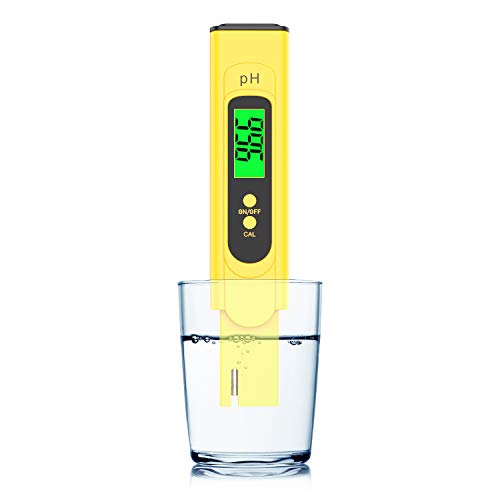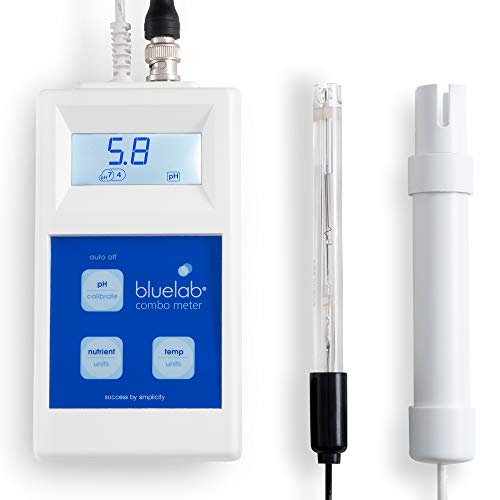All fish species have different preferences when it comes to water quality. If you don’t provide your fish with the conditions they need, your pets will become stressed, weakening their immune systems and leaving them vulnerable to common fish diseases.
Checking your fish tank water’s pH and hardness should be a part of your regular aquarium maintenance routine. So, how do you test your aquarium water pH? With a quality pH meter, of course!
In this guide, we review some of the best pH meters on the market. We also look at other ways of testing your fish tank pH to determine which method is the most accurate.
Best pH Meters on the Market Today
First of all, let’s look at the best pH meters you can buy today.
Apera Instruments AI316 Premium Series PC60
The Apera Instruments AI316 Premium Series PC60 pH meter is a very high-quality pH meter with excellent reliability.
The Apera Instruments device measures five water quality parameters, including salinity, which is perfect if you have a marine or reef tank. We love the easy to read LCD that shows multiple water parameters simultaneously, changing color relative to the mode you’re using.
What We Like:
- Measures Electrical Conductivity (EC), pH, Total Dissolved Solids (TDS), temperature, and salinity
- 0.01 pH resolution
- Comes as a complete kit including batteries
- Provides high accuracy readings
Room For Improvement:
VIVOSUN Digital pH Tester Pen
- [Widely used]: Very suitable for home or laboratory use. It is suitable for testing the pH balance of drinking water, swimming pools, aquariums, reverse osmosis systems, hot springs or hydroponics. It…
- [LCD backlit display]: PH tester bright backlit LCD display, easy to use no matter in the day and night environment, and accurate measurement and clear display results.
- [Automatic temperature compensation]: The ph meter has built-in (ATC) automatic temperature compensation function, so it no longer needs to take care of the temperature of the test liquid, so it can…
The VIVOSUN Digital pH Tester Pen is a simple to use, accurate digital pH meter that’s aimed at those who don’t want to spend a fortune on a pH tester.
The pH pen has a clear, easy to read, backlit digital display, and the device is small and compact enough to fit into your pocket. The readings are accurate to 0.01 resolution.
What We Like:
- Inexpensive
- Easy to use
- Compact and easy to transport
Room For Improvement:
- Doesn’t last long
- Calibration is unreliable
Dr.meter PH100-V
- ▶ 【Automatic Calibration】: Often troubled by calibration problem? Just one touch button can help you calibrate the digital pH tester. Featuring a three-point calibration method with simple…
- ▶ 【Convenient pH Value Reading】: Get the job done with ease. Ready to read the pH value? Just know the liquid quality with one-button lock reading function. It really is that easy.
- ▶ 【utomatic Temperature Compensation】: With automatic temperature compensation function (ATC), the Dr.meter pH meter can solve possible inaccuracy caused by the change of liquid temperature,…
The Dr.meter PH100-V pH meter is easy to use and provides accurate readings very quickly.
The device is easily portable and gives you a high resolution of 0.01, which is impressive when compared to some other pH meters. Calibration is push-button automatic, and the digital display is extremely easy to read. You also get a handy carry case for convenient portability.
What We Like:
- Simple to calibrate
- Clear display
- Compact and easy to transport
Room For Improvement:
- Poor customer service
Pinpoint pH Meter
The Pinpoint pH Meter is quite pricey when compared to some of the other options we’ve reviewed. However, this pH meter is a lab-grade device that comes with a multitude of excellent features.
The meter has a fully waterproof electrode that’s connected to the device by a 10-foot suppression cable. There’s a clear digital display that shows you the 0.01 pH resolution measurements. The pH meter comes as part of a kit that includes everything you need to begin collecting readings, such as calibration fluid, storage fluid, and a probe storage bottle.
What We Like:
- Simple 2-point calibration
- Clear display
- Accurate and reliable
Room For Improvement:
- 9V battery not included, which is disappointing considering the price of the meter
- Expensive
Bluelab METCOM Combo Meter
- Measures pH, temperature and (tds) EC, ppm 500, ppm 700 and CF with lab quality glass that can be used for the pool, drinking water, hydroponics, brewing, and growing
- EASY two point calibration and auto temperature compensation makes this digital meter a handy tool with backlit LCD display and calibration reminders
- Quickly monitor your nutrient level to maximize your grow and ensure plants get the balanced feed they need
Bluelab’s METCOM Combo Meter is the most expensive pH meter we’ve featured in our reviews and guide. However, you certainly get plenty of bang for your buck with this lab-grade device and its multitude of excellent features.
This pH meter is light and easily portable. You can use the Bluelab Combo to measure three different water parameters, including pH, conductivity, and temperature. To use the meter, hold the backlit LCD screen and insert the probe into your water sample. The digital pH meter is easy to calibrate and provides automatic temperature compensation. There’s also a low-battery indicator and an auto-off function.
As you would expect for the price, the pH meter comes as part of a full kit that includes a lanyard, calibration solution, a battery, and a long connection cable.
What We Like:
- Simple 2-point calibration
- Clear LCD screen
- Accurate and reliable
- Comes as part of a complete kit
Room For Improvement:
- Expensive
- Doesn’t display all parameters simultaneously
Extech – 5302643 PH220-C Palm pH Meter with Cabled Electrode
The Extech 5302643 PH220-C is a clever device that comes in two parts. There’s a large, clear LCD screen that you hold in your hand and a measuring probe that’s connected to the pH meter via a 39-inch cable.
The meter measures both pH and temperature, allowing you to save up to 25 separate readings within the device so that you can access your previous testing results when you want them. The measurements are set for automatic temperature compensation, and there’s buffer recognition, too.
What We Like:
- High resolution
- Clear, easy to read LCD screen
- Accurate and reliable
- Facility to save readings for future reference
Room For Improvement:
- Expensive
- Doesn’t include much calibration solution
What is the most accurate way to measure aquarium pH?
Three types of pH test kits can be used to measure aquarium pH: liquid, dip, and electronic.
Liquid Tests
Most hobbyists are familiar with liquid aquarium water test kits.
You take a sample of water in a small test tube, add the prescribed drops of fluid, and wait a few minutes until the water changes color. The results are based on the color change of the indicator fluid that’s caused by the concentration of hydrogen ions in the water. The color change is measured against a standard color chart that corresponds to a known pH.
pH tester kits vary in that some can measure a broad pH range, for example, 3 to 10. However, these kits tend to be inaccurate when the water is acidic. Better results can be obtained with test kits in the 6 to 7.6 or 7.4 to 9 pH range.
Dip Tests
Dip tests can provide a quick result, although often less accurate than a liquid test. Also, high humidity and aging cause the strips’ efficacy to deteriorate quickly, so you’ll need to replace them regularly, which is costly and wasteful.
All you do is dip the best strip into your aquarium and match the color on the chart provided.
Electronic Tests
Electronic pH tests typically boast high accuracy, even more so than liquid or dip tests.
These devices can be handheld or integral to the tank. They provide you with an instant result and are quick, convenient, and mess-free to use. Some devices use probes that contain a reference electrode and a glass electrode. The pH is determined by the measurement of the voltage between the two electrodes.
Results are strongly dependent on the quality and sensitivity of the probe. Generally, more expensive devices give you high accuracy. Some devices can even maintain and control the pre-set pH for you.
Calibration is another issue that can strongly influence the accuracy of the device. You need to calibrate an electronic pH probe regularly. Cheap probes use a one-point calibration at pH 7, whereas better quality devices have two or even three-point calibration at pH 4, pH 7, and pH 10. Some probes need to be stored wet and others dry. You must get that right because a dried out electrode won’t give you an accurate pH reading.
Are cheap pH meters accurate?
Some of the cheaper pH meter models are fairly accurate, although these devices tend to have a short lifespan. If you can afford it, buy a lab-grade pH meter, which will last longer and deliver more accurate results.
Which is more accurate, pH paper or pH meter?
Overall, tests show that pH meters are generally more accurate and deliver more reliable results than dip tests or liquid tests.
For the pH in your tank to remain stable, the correct buffering capacity is essential. To measure the buffering capacity, you need to perform a carbonate hardness (KH) test and make any necessary adjustments.
When the pH is close to neutral, and the KH is relatively high, the results of most pH tests will be fairly accurate. However, once you move toward lower pH values, especially if paired with a low concentration of carbonate, the results are more variable.
How to use a pH meter
Having chosen your pH meter, you need to know how to use it.
Most pH meters are very similar in how they work, but you should always check the manufacturer’s directions before you begin.
Here’s a general guide:
Calibrate the meter
Before you can test the water in your aquarium, you need to calibrate the pH meter. To do that, gather together the calibration solutions that you got with your kit and take the pH electrode probe.
Clean the electrode probe using deionized water, and then blot it dry with a clean cloth or paper tissue. Now, put the probe into a pH 7 solution and allow the probe to stabilize. Program the meter so that it reads 7.0. That sets the meter ready for the next time it’s used.
Repeat the process, but this time, use a buffer solution of pH 2.0. Remove the probe from the solution, rinse it, and then dry it with a clean cloth or a paper tissue.
The pH meter is now calibrated and ready for use.
Taking pH readings
Once you’ve finished the calibration process, you’re ready to start taking pH readings from your aquarium water. Switch on the meter and allow it to adjust; that usually takes just a few minutes. Set the meter to pH mode.
Put the probe into your water sample and leave it in there for a few minutes. It’s important not to withdraw the probe too soon, or the reading won’t be accurate. Allow the numbers to stabilize before you note the reading.
When you have your reading, rinse the pH meter and place it into the storage solution.
How often should you calibrate your pH meter?
For your pH meter to work well, you need to calibrate it, but how often do you need to do that?
The frequency with which you calibrate your pH meter depends on several factors. If you have a pH meter with very high accuracy, you need to recalibrate the device before each use. Cheaper, more general meters can generally be calibrated every couple of weeks.
However, there are a few occasions when you should calibrate your pH meter regardless of its accuracy. For example, if you haven’t used the electrode before or if it’s been kept in storage for a long time, you should calibrate it. Recalibration is also required after you’ve measured a very strongly acidic solution or a strong base. You should also calibrate your device again if there was a marked difference between the temperature of the buffer and the water sample you tested.
Why is aquarium water pH so important for your fish?
So, now you know more about pH meters and how to use one, let’s look at why the pH of your aquarium water is so important for the health of your fish.
What is pH?
pH is the term that’s used to describe how basic or acidic a substance is. The H stands for the number of hydrogen ions and hydroxide ions that a liquid contains, your aquarium water, for example.
The lower the number of hydrogen ions, the more acidic the water. Conversely, the more hydrogen ions there are, the more basic the water. The pH scale is used to illustrate the various water conditions.
- Pure water has a neutral pH of 7.0.
- Milk has a pH level of 6.0.
- Lemon juice has a pH level of 2.0.
So, you can see that the lower the number, the more acidic the substance. pH levels of 7.0 or more are alkaline or basic.
pH levels and your fish
Aquarium fish thrive when the pH in their tank water matches that of their natural habitat. The pH preference of different species varies. For example, Koi carp prefer a pH of 7.5, although they can tolerate water as high as 8.2. African cichlids need water that is more alkaline with a pH of 8.5.
Harmful pH levels
If the pH in the water becomes too acidic, it can actually burn the fish’s skin. Similarly, if the water is very basic or alkaline, that can cause chemical burns to your fish’s skin. Generally, young fish are more sensitive to high acidity than mature specimens. If the pH falls as low as 5.0, that will be too acidic for fish eggs and will kill them before they hatch.
pH level adjustment
You should test the pH levels in your fish tank each week to ensure that they haven’t changed. If the pH level falls too low, that means the water is too acidic. You can raise the pH level by adding crushed coral or limestone to the water, oxygenate the tank using an air pump to get rid of carbon dioxide or use a suitable chemical buffer to neutralize the acidity and bring the pH closer to neutral, or 7.0.
Some areas have naturally hard water or water that has a high pH. You can lower that by adding a chemical acid buffer, water softener, or filtering the water across peat moss.
In conclusion
Maintaining the correct pH levels for the species of fish you keep is essential for the health of your livestock.
To ensure that the pH in your fish tank is correct for your fish, you’ll need to test the water every week as part of your regular maintenance routine. The most accurate test results are obtained by using an electronic pH meter. All the devices we’ve reviewed in this guide are perfect for that job, so go ahead and order one today!





























